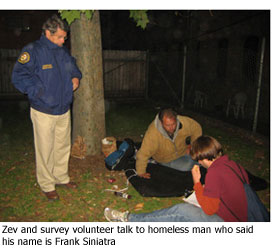Hope on the streets of Hollywood
May 3, 2010
 My alarm went off at 3:00 a.m., rousing me from bed for a trip to Hollywood to participate in a new count of homeless people—one in a series of such surveys conducted in Skid Row and throughout my supervisorial district during the past 2 ½ years.
My alarm went off at 3:00 a.m., rousing me from bed for a trip to Hollywood to participate in a new count of homeless people—one in a series of such surveys conducted in Skid Row and throughout my supervisorial district during the past 2 ½ years.
The purpose of this count, like the others, was to identify as many homeless people as possible and determine who among them is most likely to die on the streets unless they’re given the services and housing they desperately need. Each individual is asked a series of scripted questions about their health, mental health, substance abuse, economics or any combination of the above.
At the end of this week’s three-day Hollywood survey—conducted under the guidance of Common Ground, a New York-based non-profit that pioneered this technique—a list will be turned over to the county and its service providers. We then will begin the delicate and difficult process of convincing these vulnerable individuals to accept our offer of housing and services.
The team I joined on Monday covered an area bounded by La Brea, Highland, Franklin and Sunset. Our team leader was a highly motivated and passionate intern from People Assisting the Homeless (PATH) by the name of Alex Cornell, who is pursuing a divinity degree. We were told we needed to complete our survey before sunrise, in the hours before the homeless would begin to scatter for the day.
In the pre-dawn chill, in the shadow of boutique hotels and gentrified storefronts, we found people asleep on church steps, in parks and on bus benches. Alex gently approached each of our prospective clients and asked if they’d cooperate in answering the questionnaire. As an inducement, they were offered a $5 coupon from Subway sandwiches. While most agreed to participate, some wanted only to be left alone, despite our offer of food.
I have to confess that I had not planned to spend the whole 2 ½ hours on the streets of Hollywood in the middle of the night interviewing the homeless. But once I got started, I couldn’t stop. With each person we interviewed, I felt a sense of responsibility to them and an even greater sense of the possibilities we could offer to help avert a tragic end to their lives.
The first man we found was sleeping in a pocket park off of Franklin Avenue. He’d been homeless for 8 years, most of them in Hollywood and most of them in that park. He said he’d suffered a traumatic brain injury in an accident some years ago and had no memory of anything. His name, he said, was Frank Sinatra. I suspect he’ll end up on Common Ground’s “vulnerability index” as one of the homeless who’ll rank among the area’s most likely to die on the streets without services and housing.
As we walked down La Brea Ave. between Hollywood and Sunset, we found a man in his late 50’s sleeping on a cot in the front yard of an apartment building. He offered a different face of the problem of homelessness on our streets.
Homeless for two months, he said he has a B.A. from UCLA and was honorably discharged from the United States Navy. I asked what precipitated his life of homelessness in Hollywood. He said that he’d been living with his mother in Altadena when her failing health forced her to move into a convalescent hospital. To pay the costs, she needed to sell her house, leaving her son without a roof.
One of our other teams found a colony of homeless people living in the hills above the Hollywood Bowl—more than 20 of them led by their “mayor,” an armed forces veteran who has been homeless for more than two decades. One of the tragedies of homelessness in our country is that somewhere between 20% and 25% of the homeless are veterans of our armed forces. They answered the call of our nation, and now it’s time for us to answer their call for help.
That’s what the Hollywood homeless count is all about. We’ve already had success with this approach in Skid Row, in Venice, in Santa Monica and in other communities, where “permanent supportive housing” will be provided in the months ahead to nearly 500 of the most chronically and vulnerable homeless on our streets.
These are the individuals who’ll end up in our jails and emergency rooms multiple times during the course of a year if they’re not housed and provided with crucial health and mental health services. On the streets, they run up a fortune in health and incarceration costs. Providing them with permanent supportive housing will actually save our county and society money because these individuals will no longer end up in jail or in emergency rooms with anything approaching the same frequency.
I know that the magnitude of our homeless problem can seem intimidating and insurmountable. But this is a problem of individual lives, not statistics. Common Ground’s “vulnerability index” gives us a biography of sorts for each of these people, giving us new and deeper insights into their struggles and exactly what they need to have lives restored. Our job is to take those biographies—those life stories—and change their trajectories.
To see a video of Zev addressing homeless volunteers before heading onto the streets, click here.
Posted 4-29-10
Read related story
Meet Kerry Morrison, who represents Hollywood business and organized the homeless count.












 405 bridge work causes a stink
405 bridge work causes a stink





